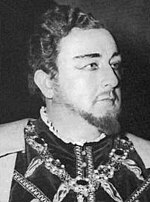Search Results - Tagliabue, Carlo, 1898-1978
Carlo Tagliabue
 Carlo Pietro Tagliabue (January 13, 1898 in Mariano Comense – April 5, 1978 in Monza) was an Italian baritone.
Carlo Pietro Tagliabue (January 13, 1898 in Mariano Comense – April 5, 1978 in Monza) was an Italian baritone.According to Tagliabue, his love for singing began at a young age, when his father would take him to performances at La Scala. Carlo would return singing arias in a baritone voice disproportionate to his age. He also failed his childhood choir class because he wanted to sing in a big voice and grand manner, while they required the typical boy treble voice. Around age 17 he began two years' study of music and singing under Corrado Mattioli, a teacher and director of the choral division of the Civiche Scuole popolari di Musica in Milan.
After a brief conscription during World War I, he returned to Milan and studied for one year with Leopoldo Gennai—a repertoire coach from La Scala—and Annibale Ghidotti, a blind singing teacher who, it was said, could identify a student's voice type simply by feeling their throat.
Tagliabue made his debut in Lodi, Lombardy, in ''Loreley'' and ''Aida''. His debuts in Genoa (1923), Torino, La Scala (1930), Rome (1931), and Naples (1931) were all in ''Tristan und Isolde'' (sung in Italian). He also performed in Wagner's ''Götterdämmerung'', ''Tannhäuser'' and ''Lohengrin''. However, Tagliabue would go on to excel in the Verdian repertoire, especially ''La forza del destino'', ''Aida'', ''Rigoletto'', ''La traviata'', ''Nabucco'', and ''Otello''. He created the role of Basilio in Respighi's ''La fiamma'' in 1934.
His international career included Buenos Aires' Teatro Colón (1934), the Metropolitan Opera, New York City (1937–39), and San Francisco Opera and Covent Garden, London (1938). Tagliabue's last performance was in 1955 at La Scala, at the famous performance of ''La traviata'' conducted by Carlo Maria Giulini and directed by Luchino Visconti, where Maria Callas scandalized the public by throwing her shoes off.
In his book ''Voci Parallele'' Giacomo Lauri-Volpi wrote, "[Tagliabue] is the only survivor of a school that knows that in Rigoletto, in Ballo in Maschera, Trovatore, Traviata a melodramatic piece should be sung, measured and breathed musically in line with the mastery of great art." Provided by Wikipedia
- Showing 1 - 9 results of 9
-
1
Il trovatore by Verdi, Giuseppe, 1813-1901
Published: Everest, 1967Other Authors:Description: 3 audio discs ; 12 in. : 33 1/3 rpm. microgroove.Call Number: Loading…
Located: Loading…Phonograph Audio Loading… -
2
La traviata opera in three acts by Verdi, Giuseppe, 1813-1901
Published: Plymouth, 1950Other Authors:Description: 3 audio discs : analog, 33 1/3 rpm ; 12 in.Call Number: Loading…
Located: Loading…Phonograph Audio Loading… -
3
La favorita by Donizetti, Gaetano, 1797-1848
Published: Everest, 1967Other Authors:Description: 3 discs. : 33 1/3 rpm., monophonic ; 12 in.Call Number: Loading…
Located: Loading…Phonograph Audio Loading… -
4
La traviata by Verdi, Giuseppe, 1813-1901
Published: Golden Age of Opera : Distributed by Bongiovanni, 1995Other Authors:Description: 2 audio discs : digital, monophonic ; 4 3/4 in.Call Number: Loading…
Located: Loading…CD Audio Loading… -
5
La forza del destino by Verdi, Giuseppe, 1813-1901
Published: EMI, 1997Other Authors:Description: 3 audio discs (2 hr., 45 min.) : digital, monophonic ; 4 3/4 in.Call Number: Loading…
Located: Loading…CD Audio Loading… -
6
I vespri siciliani dramma in cinque atti by Verdi, Giuseppe, 1813-1901
Published: Claque, 1990Other Authors:Description: 2 audio discs : digital ; 4 3/4 in.Call Number: Loading…
Located: Loading…CD Audio Loading… -
7
Tannhäuser by Wagner, Richard, 1813-1883
Published: Hardy Classic, 1999Other Authors:Description: 3 audio discs : digital ; 4 3/4 in.Call Number: Loading…
Located: Loading…Audio Loading… -
8
Tebaldi sings Wagner by Wagner, Richard, 1813-1883
Published: Standing Room Only, 1991Other Authors:Description: 1 audio disc (75 min., 48 sec.) : digital, stereophonic ; 4 3/4 in. + 1 booklet.Call Number: Loading…
Located: Loading…CD Audio Loading… -
9
La forza del destino by Verdi, Giuseppe, 1813-1901
Published: Cetra Soria ; Released by Raxor Corp., 1942Other Authors:Description: 18 audio discs : analog, 78 rpm ; 12 in.Call Number: Loading…
Located: Loading…Phonograph Audio Loading…